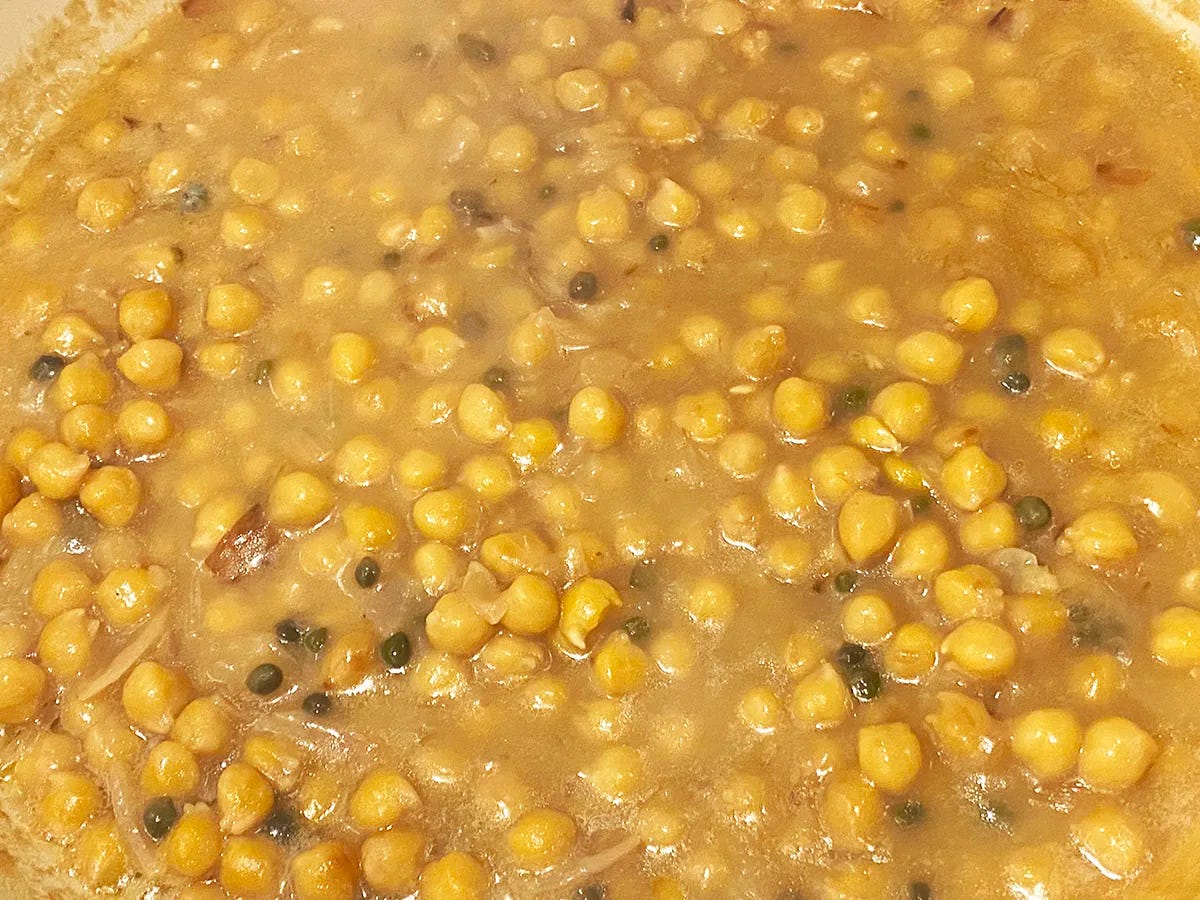Food Notes: 5/13
Chickpeas, piccata, food documentaries, food movies, and more
A few weeks back while poking around on Substack, I came across a post about chickpea piccata. This winter, I had made a few chicken piccata dishes while writing the history of Chicken Francese, so I decided I wanted to try a lemony, capery chickpea version.
The opportunity came earlier this week after my wife made a soup. She’d made it with spinach and chickpeas, but had cooked chickpeas leftover. We had also had half bottle of white wine, and capers left from a salad. Having already amassed most of the ingredients, I set to work.
We also decided to turn the dish into a sauce for pasta rather than a standalone entree. The pasta we chose was cheese tortellini, a personal favorite, but in this case added some substance to the chickpeas. (We didn’t make stuff these ourselves).
Since we were pouring this over pasta, I wanted to make sure there was enough liquid, but also that it was thick enough to coat the pasta. I’ve made chicken piccata where the sauce is too liquid, usually when we’re rushing and don’t have time to let it cook down.
I flipped through the top recipes on Google for chickpea piccata but didn’t bother using them. They were all highlighting how the resulting dish was vegan. Sure, I wasn’t using chicken, but I definitely wanted to use butter and chicken stock.
I decided to go my own way loosely following the preparation for chicken piccata. I coated the chickpeas with rice flour hoping this would help crisp them up a bit. Rice flour is great for frying vegetables with a light, crispy coating. It mostly worked, but I also may had shorted the amount of starch in the base sauce. This would haunt me in a few minutes and I would have to resort to whipping up a roux with flour and butter.
I cooked the chickpeas in butter, and then added in shallots and some garlic. When the shallots softened, I added lemon juice, chicken stock, and capers, plus the remaining chickpea water. This boiled for a bit, and then I mixed just a little bit of the roux to help thicken everything. By then the tortellini were ready and I mixed them in too.
The dish worked out great in the end, especially with a little cheese grated on top. It was very lemony—I juiced two lemons—but didn’t bother tossing in whole slices. Poaching lemon medallions would have brought a bit of bitter to the party balancing the acid, but the texture was probably incorrect for combining with pasta. In the end, this dish turned out great for leftovers too.
The Latest
Marcella, the Movie
I had a chat with Peter Miller, the filmmaker behind the new documentary, Marcella. We talked about process, Steve Sando, and how Marcella changed American cooking and the perception of Italian cuisine.
Nonna’s, a Netflix Movie
Vince Vaughn stars in the dramedy about an Italian American man buying an abandoned restaurant on Staten Island and hiring elderly Italian grandmothers to staff the kitchen. The hilarious premise falls flat in a number of ways. Food writer John Mariani eviscerated the film on LinkedIn.
Memoir, with a Side of Citrus
I reviewed Katie Goh’s memoir, Foreign Fruit, a book that combines the global history of citrus with the personal endeavor to explore the author’s family history.
Speaking of Citrus, Let’s Get Lemony
Everything can be an adjective in 2025. You might have noticed I like to throw around food flavors ending in “y” (i.e. garlicky). That’s an intentional affectation ironically poking at recent food writing trends. Eater’s conclusion was that Alison Roman helped launch the fad, thanks to editors at Bon Appétit. This week I couldn’t help but notice how the major food media was pushing “lemony,” which is ironic since I made my own lemony chickpea piccata:
Have we gone too far, internet?
Hibachi History
Over at Taste, Londyn Crenshaw looks back at the history of hibachi in America from Benihana to Tokyo Hibachi Steak House in Fresh Meadows Queens, where you can find halal hibachi.
Fennel
Serious eats explains fennel, from bulbs to seeds. My grandfather used to eat fresh pieces of fennel after meals, to help with digestion. This is the basis of most traditions in Italian cuisine—helping with digestion. My mother still puts out fresh pieces of fennel at Thanksgiving with the fruits and nuts after dinner.



